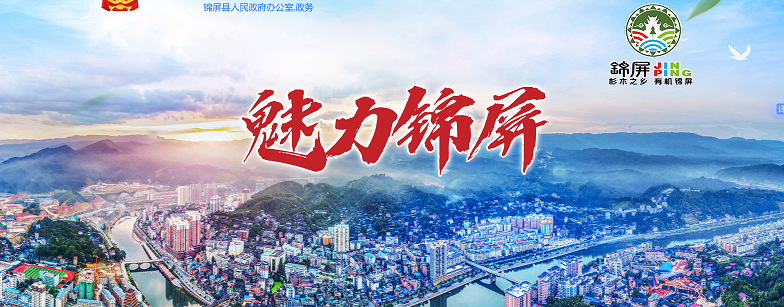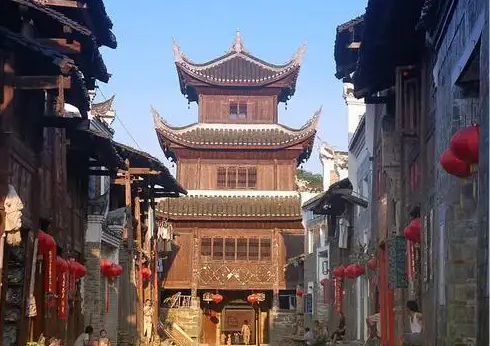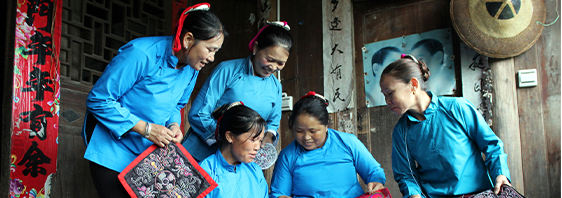- Profile Jurisdictions GOV DEPARTMENTS Cultures Travelling Educate
-
Jinping County is located in the southeastern part of Guizhou Province, in the eastern part of Qiandongnan Prefecture. It borders Jingzhou County in Hunan Province to the east, Liping County to the south, Jianhe County to the west, and Tianzhou County to the north. It serves as an important gateway connecting Qiandongnan to Hunan, Guangdong, and Guangxi provinces, and is part of the Pan-Pearl River Delta region and the Yangtze River Economic Belt. To the north, it connects to the Chengdu-Chongqing Metropolitan Area, to the east, it connects to the Central Urban Agglomeration; to the south, it links to the Guangdong-Hong Kong-Macao Greater Bay Area and the Beibu Gulf Economic Circle. The Sanli Expressway runs through the county, while the Songcong Expressway intersects with National Highway 242, Provincial Highway 311, and Provincial Highway 403 to form a network. The planned Yuping-Congjiang Intercity Passenger Dedicated Line will connect the Shanghai-Kunming High-Speed Railway with the Guangxi-Guangzhou High-Speed Railway and establish a station in Jinping. It is 358 kilometers from Guiyang, the capital of Guizhou Province, 182 kilometers from Kaili, the capital of Qiandongnan Autonomous Prefecture, 79 kilometers from Jingzhou Railway Station in Hunan Province, 80 kilometers from the Sansui Station of the Shanghai-Kunming High-Speed Railway, 60 kilometers from Liping Airport, and 110 kilometers from the Congjiang Station of the Guizhou-Guangdong High-Speed Railway. The county has a total area of 1,619.14 square kilometers, comprising 7 towns, 8 townships, and 1 provincial-level economic development zone. It has 115 administrative villages (communities). As of the end of 2024, the county had a registered population of 239,069 and a permanent resident population of 155,400. It is home to 19 ethnic groups, including the Dong and Miao, with minority ethnic groups accounting for 89.88% of the total population. It is a national pilot county for comprehensive reform of collective forestry, a national model county for ethnic unity and progress, a national “three-zero county” for petition work, a national key county for rural revitalization assistance, and a county in Guizhou Province focusing on laying a solid foundation for rural revitalization. It is also a revolutionary old area and a national key ecological function zone. It is the hometown of Long Daodao, one of the 24 martyrs of Longhua and an early leader of the Chinese workers' movement, and Long Yun, the commander of the 18th Red Army Division.

Jinping is named for its lush green mountains and picturesque landscapes, resembling a brocade screen. It lies within the subtropical humid monsoon climate zone, where the Qingjiang River, Xiajiang River, and Liangjiang River converge. The county is rich in forest resources, green stone, and hydropower, with stone reserves of 130 million cubic meters and hydropower installed capacity of 118 megawatts. It is renowned as the “Hometown of Cypress Trees,” “Hometown of Green Stone,” and “Hometown of Hydropower.” It boasts 4 national-level forest villages, 5 provincial-level forest towns, 14 provincial-level forest villages, and 150 provincial-level forest households. As of 2024, the forest area spans 186,600 acres, with a forest coverage rate of 74%. The air quality is excellent, with negative ion concentrations consistently above 26,000 per cubic centimeter, making it a natural “air conditioner” and “oxygen bar.” The water quality of urban and rural centralized drinking water sources and surface water at the provincial border meets standards at a 100% rate, with all environmental indicators ranking among the top in the province and prefecture.

Jinping boasts significant cultural tourism resources, serving as the birthplace and core area of the “Wood Merchants Culture” along the Qingjiang River. It is a multicultural hub integrating minority culture, wood merchants culture, red culture, and military garrison culture. The region preserves over 100,000 Jinping documents listed in the “China Archives and Documentary Heritage Directory,” as well as a well-preserved Ming Dynasty military fortress with a history of over 600 years. China's Historical and Cultural Village and National 4A-rated tourist attraction—Longli Ancient City, China's Scenic Village and dubbed the “First Ethnic Environmental Protection Village of the Century,” National 3A-rated tourist attraction—Wendou Miao Village, China's largest rural collective forest farm and Provincial Forest Park—Chunlei Forest Farm, China's Ecological Cultural Village and National 3A-rated tourist attraction—Pingao Scenic Area, and the 3,000-kilometer waterway, the 600-year-old national 3A-rated tourist attraction—Maoping Wood Merchants Ancient Town, Guizhou Province's modern efficient agricultural park and national 3A-rated tourist attraction—Longchi Colorful Farmland, the national ecological home demonstration village, national key rural tourism village, and Guizhou Province's “Top Ten Beautiful Villages”—Leitun, Guizhou's “Charming Dong Village” — Yaobai Village, Jinheng Sanjiang National Water Conservancy Scenic Area, Qing Shan Jie's 50,000-mu natural grassland, and the stunningly beautiful Sanbanxi Lake, among other abundant tourist resources, serve as a green, ecological, and environmentally friendly calling card.

Rich ethnic cultural heritage. The “Jinping Documents” promote values of integrity, ecology, etiquette, and harmony, setting a global benchmark in ecological conservation. The Dong silverware forging technique and Dong embroidery, two intangible cultural heritage crafts, have been featured on China Central Television's “Fashion Masters” and “Chinese Nation” programs. The traditional planting and management system of cypress trees in Jinping County, Guizhou Province, has been included in the National List of Important Agricultural Cultural Heritage.

Jinping County adheres to Xi Jinping Thought on Socialism with Chinese Characteristics for a New Era as its guiding principle, prioritizes high-quality development, focuses on the “Four New” main objectives and the “Four Modernizations” main strategies, and fully promotes the development of the ecological goose and ironstone orchid industry chains. It coordinates efforts to stabilize growth, promote reform, adjust structure, improve people's livelihoods, and prevent risks, achieving steady progress in socio-economic development and improvements in people's livelihoods, presenting a new outlook. In 2024, the county's GDP, agricultural production, trade, finance, and urban and rural residents' income all grew steadily. The scale of industrial production grew rapidly, investment saw a slight increase, the service sector grew at a faster pace, and fiscal revenue growth was lackluster. In 2024, the county's GDP reached 6.496 billion yuan, representing a year-on-year increase of 6.3%. Among these: The added value of the primary industry was 1.241 billion yuan, representing a year-on-year increase of 4.5%; the added value of the secondary industry was 1.574 billion yuan, up 9.7% year-on-year; and the added value of the tertiary industry was 3.681 billion yuan, up 5.6% year-on-year. The proportion of the three industries was 19.1:34.2:56.7. The added value of large-scale industrial enterprises in the county reached 896.13 million yuan, up 52.3% year-on-year. Among these: the added value of large-scale mining industries was 5.94 million yuan, a year-on-year decrease of 15.4%; the added value of large-scale manufacturing industries was 292.73 million yuan, a year-on-year decrease of 9.2%; the added value of large-scale power production industries was 597.46 million yuan, a year-on-year increase of 126.1%; the county's fixed-asset investment of 5 million yuan or more reached 1.706 billion yuan, a year-on-year increase of 2.0%; Real estate development investment reached 375 million yuan, up 25.7% year-on-year; the sales area of commercial housing reached 83,104 square meters, up 21.3% year-on-year; the total output value of agriculture, forestry, animal husbandry, and fisheries in the county reached 2.108 billion yuan, up 4.5% year-on-year; the county's total fiscal revenue reached 452.91 million yuan, down 3.3% year-on-year, of which: general public budget revenue reached 255.92 million yuan, up 3.2% year-on-year. General public budget expenditure reached 231.363 million yuan, up 21.2% year-on-year; the total balance of deposits and loans in financial institutions across the county reached 21.862 billion yuan, up 5.7% year-on-year, of which: the total balance of deposits in financial institutions reached 10.546 billion yuan, up 3.6% year-on-year, and the total balance of loans in financial institutions reached 11.316 billion yuan, up 7.7% year-on-year; premium income reached 98.54 million yuan, up 9.2% year-on-year. The total retail sales of consumer goods in the county reached 3.09 billion yuan, up 3.3% year-on-year. The sales (turnover) of the wholesale, retail, accommodation, and catering industries in the county reached 597 million yuan, 3.154 billion yuan, 47 million yuan, and 316 million yuan, respectively, with growth rates of 6.6%, 5.7%, 5.8%, and 8.1% year-on-year, respectively. The per capita disposable income of urban residents was 40,570 yuan, up 4.4% year-on-year; the per capita disposable income of rural residents was 14,252 yuan, up 7.7% year-on-year.
contact details
Tel:00-86-0855-7221793
Address:Room 608, County Party Committee and County Government Comprehensive Building, Dantou Community, Sanjiang Town, Jinping County, Guizhou Province
Working hours:Morning: 8:30 a.m. to 12:00 p.m. (excluding public holidays) Afternoon: 2:00 p.m. to 5:30 p.m. (excluding public holidays)
